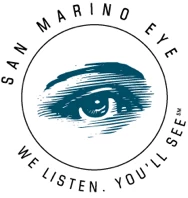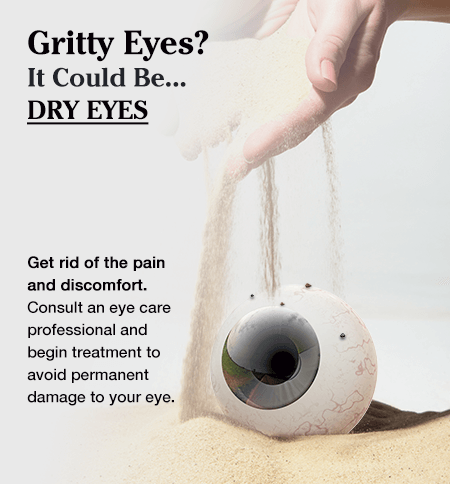Dry Eye Syndrome
Gritty Eyes? It Could Be Dry Eyes
Prevalence, Symptoms, Causes, Complications, Tests, and Treatments
Dry Eyes – What Is It?
Dry Eyes is a condition in which there are not enough tears to lubricate and nourish the eyes. Other names for dry eye include aqueous tear deficiency, dry eye syndrome, dysfunctional tear syndrome, evaporative tear deficiency, keratoconjunctivitis sicca (KCS) and lacrimal keratoconjunctivitis.
The term “dry eyes” is not as simple as it may sound. It actually is quite complex. It involves the quantity or tears, quality of the tears, or both.
- Decreased in the production of tears by the lacrimal gland so there is not enough moisture for your eyes. This is fairly common in people older than 50 years, and especially afflicts women more than men.
- Decreased in the quality of tears produced by the lacrimal gland. Tears are a combination of several substances, namely: oil, water, mucus, and antibodies and special proteins. Any problems with any of these components can cause Dry Eyes.
Symptoms of Dry Eyes
Here are some of the common signs and symptoms associated with Dry Eyes:
- Blurred or double vision
- Dull pain and/or feeling of weight on the eyelids
- Eye tiredness and/or soreness
- Feeling of dirt, sand, foreign object in the eye
- Mild swelling of eyelid
- Redness of the eyes
- Sensitive eye reaction to smoke, air, and light
- Stinging, scratchy and burning sensation in the eyes
- Stringy mucus, usually yellowish, in or around the eyes
In some instances, dry eyes cause excessive tears. This is just the nervous system’s protective mechanism at work. But this liquid is mostly water and lacks the composition of the normal tears for the proper lubrication of the eye.
Risks and Complications of Dry Eyes
Dry Eyes has become so common nowadays that many, including you, may dismiss it as a mere result of eye fatigue due to your day-to-day activities and ignore it altogether.
Although generally, dry eyes do not cause serious problems (only discomfort and interruption to normal activities), if left untreated, it can lead to more complications like 1) Corneal ulcer (ulcerative keratitis), an inflammatory infection where there is abrasion or scarring of epithelial layer of your cornea which may result to blindness, and 2) Conjunctivitis (pink eye), an inflammation of the conjunctiva, where the whites of the eyes look inflamed, and red or pink.
Treatments for Dry Eyes
Depending on the underlying cause(s) of dry eyes, several treatments can be done, all with the primary aim of keeping the eye adequately lubricated.
Some of these treatments include:
- Antibiotic drops
- Applying a warm compress to the outer eyelids
- Artificial tears
- Corticosteroids drops to control inflammation
- Discontinuance of contact lens usage
- Eye ointments
- Immune suppressing cyclosporine (Restasis) drops
- Eye Closure/Rest
- Natural treatment such as Omega 3
- Salivary gland transplantation
- Scleral contact lens
- Special eyewear
- Thermal cautery
More information here: How to Relieve Dry Eye Syndrome
Why Go To An Ophthalmologist When You Have Dry Eyes?
The discomfort and interruption of daily activities caused by dry eyes make this condition one of the most common reasons why people visit their eye doctor. However, Dry Eyes may also have serious underlying causes such as diabetes, hypothyroidism, fibromyalgia, dehydration, lupus, rheumatoid arthritis, scleroderma, sjogren’s syndrome, vitamin A deficiency, and the blinding disease: glaucoma. That said, early diagnosis and treatment of dry eyes by a Board-certified Ophthalmologist is strongly advised.
References:
- Diseases and Conditions Dry Eyes. August 4, 2012. http://www.mayoclinic.org/diseases-conditions/dry-eyes/basics/definition/con-20024129 (accessed January 24, 2015).
- Facts About Dry Eyes. August 2009. https://www.nei.nih.gov/health/dryeye/dryeye (accessed January 25, 2015).
- Hypothyroidism – Signs and Symptoms. March 3, 2014. http://www.thyroiduk.org.uk/tuk/about_the_thyroid/hypothyroidism_signs_symptoms.html. Market Scope, November 2011. National Eye Institute (NEI). August 2009. https://www.nei.nih.gov/health/dryeye/dryeye (accessed January 25, 2015).]
MILLION
Dry eye affects an estimated 25 million people in the United States and is one of the most common reasons that people visit their eye doctor.
[Source: Market Scope. 2011 Comprehensive Report on the Global Dry Eye Products Market. St. Louis, Mo: Market Scope, November 2011]
Studies indicate that prevalence of Dry Eyes increases with age. It is estimated that 3.2 million women and 1.68 million men, age 50 and over have dry eyes.
[Sources: Schaumberg DA, Dana R, Buring JE, Sullivan DA. Prevalence of dry eye disease among US men: estimates from the Physicians’ Health Studies. Arch Ophthalmol. 2009;127:763-8 and Schaumberg DA, Sullivan DA, Buring JE, Dana MR. Prevalence of dry eye syndrome among US women. Am J Ophthalmol. 2003;136:318-26.]
Got a Question?
Please don't hesitate to ask us. We will get back to you shortly.
Experience the Difference…
Patient-Focused Care • Tuesday to Saturday Appointments • Available by phone 24/7
Care Just like the good old days!



